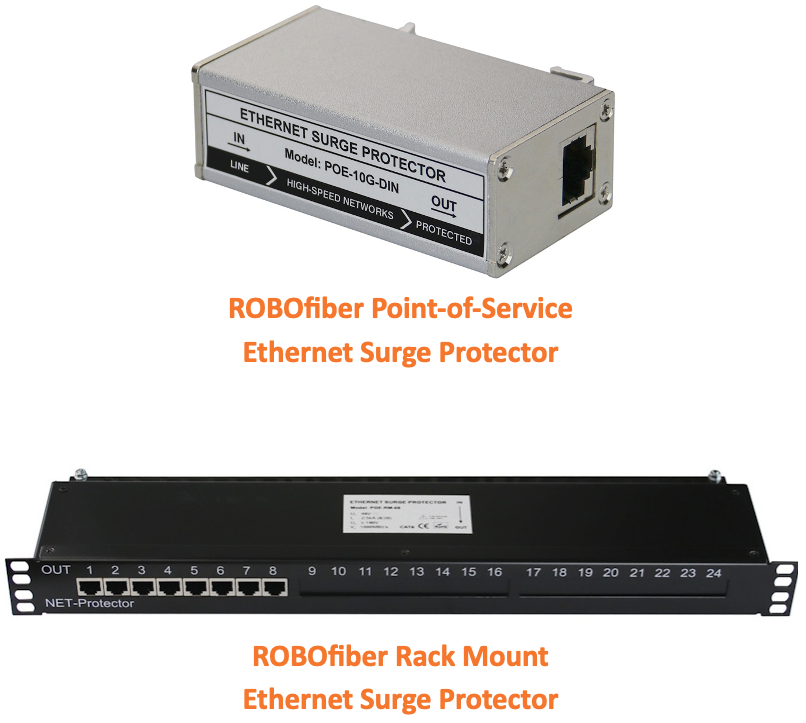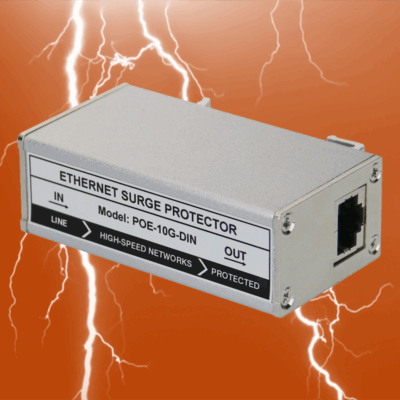Power conditioning and AC surge protection is a common investment for racks and expensive distributed electronics. After all, we know problems commonly affect the power grid. But what about the network infrastructure that connects our devices? Is that also at risk?
Ethernet cabling is the backbone of modern data, security and audio-visual networks. We depend on twisted pair to connect our distributed internet systems and extend our IP cameras; however, one of the most overlooked vulnerabilities in copper-based structured cabling is surge damage. Whether from nearby lightning strikes, power fluctuations or electromagnetic interference, surges can travel along Ethernet runs and cause catastrophic damage to connected equipment.
Even a transient voltage spike lasting less than a millisecond can destroy sensitive network electronics like switches, cameras, access points, AV over IP transceivers, converters and extenders. The cost of replacing devices and the downtime from outages can far exceed the price of proper surge protection as we’ll learn from the article below.
Where Surges Come From
We all know that lightning is a potent cause of surge damage and, yes, a direct lightning strike can be catastrophic to a structure, its network and the electronics within. However, most low-voltage surge damage originates from more modest means:
- Indirect lightning strikes — nearby hits can induce high-voltage transients in outdoor cabling
- Electrostatic discharge (ESD) — static electricity can be released when plugging or unplugging cables
- Power cross events — accidental contact between data lines and electrical conductors
- Ground potential differences — mis-matched circuits and ground planes between multiple buildings and remote networks
Outdoor cable runs, rooftop Wi-Fi access points and security cameras mounted on poles are especially at risk. Even short outdoor or building-to-building connections can act as antennas for electrical disturbances.
The Protected Cable Myth
Many people believe that shielded twisted pair cables, underground direct burial cables, armored above ground cables and runs installed in conduit are immune to surges. This simply isn’t true.
Shielding and armoring do reduce electromagnetic interference and cable crosstalk; however, they won’t completely protect against voltage surges. As discussed above, surges often originate at the point of connection or as a high-voltage transient in the natural environment, and cables — especially those run outdoors — remain at risk.
 How Surge Protection Works
How Surge Protection Works
When installed inline on a cable run, Ethernet surge protectors monitor signals to ensure they remain within specifications and instantly act when issues are detected.
- Voltage monitoring — surge protectors allow a predetermined voltage range to pass-through. For example, the ROBOfiber POE-10G-DIN protector supports 10G ethernet and PoE during normal operation but will stop electrical signals above 58V.
- Voltage clamping — when non-conforming voltage is detected, the surge protector’s built-in diodes and gas discharge tubes will activate and clamp down the unsafe signal, creating an air gap between the source and downline electronics.
- Voltage diversion — the surge protector then diverts the excess voltage through a ground wire connected to a grounded AC outlet, grounding rod or other separate ground point.
Additionally, surge protectors actually optimize signal integrity by minimizing capacitance and ensuring data rates and power pass-through (PoE, PoE+, etc.) conforms to Cat5e, Cat6 and Cat6A specifications.
Installing Surge Protection: Next Steps
While surges can impact any low-voltage connection, cables installed outdoors are at greatest risk. Outdoor security cameras, remote wireless access points and building-to-building network runs are exposure points that lead to electronics and broader networked systems. To implement proper Ethernet surge protection, we recommend:
- Assess exposure points — where do cables enter and exit buildings? What’s their path and how exposed are they?
- Identify the proper surge protection hardware — are you protecting a single cable run? Or do you need multiple run protection in a consolidated rack or enclosure? Does the surge protector accommodate your signal types (bandwidth, PoE, etc.)?
- Install the surge protectors at both ends of the cable run for maximum protection.
Finally, it’s best practice to inspect all surge protectors on a regular basis, as they degrade over time.
Final Thoughts
A single $100 Ethernet surge protector can prevent thousands of dollars in replacement equipment and customer frustration. Including surge protection in every outdoor or exposed Ethernet installation isn’t just a best practice — it’s a professional standard that protects both your customers and your reputation.
Future Ready Solutions and ROBOfiber offer a variety of Ethernet surge protectors in rack mount and point-of-service formats. Prices are extremely affordable, and models support signals up to 10G with PoE+.
Learn more at www.futurereadysolutions.com.

